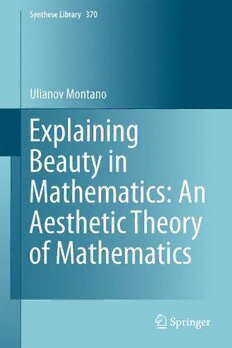
Explaining Beauty in Mathematics: An Aesthetic Theory of Mathematics PDF
Preview Explaining Beauty in Mathematics: An Aesthetic Theory of Mathematics
Synthese Library 370 Ulianov Montano Explaining Beauty in Mathematics: An Aesthetic Theory of Mathematics Explaining Beauty in Mathematics: An Aesthetic Theory of Mathematics SYNTHESE LIBRARY STUDIESIN EPISTEMOLOGY, LOGIC, METHODOLOGY,AND PHILOSOPHY OFSCIENCE Editors-in-Chief: VINCENTF.HENDRICKS,UniversityofCopenhagen,Denmark JOHNSYMONS,UniversityofTexasatElPaso,U.S.A. HonoraryEditor: JAAKKOHINTIKKA,BostonUniversity,U.S.A. Editors: DIRKVANDALEN,UniversityofUtrecht,TheNetherlands THEOA.F.KUIPERS,UniversityofGroningen,TheNetherlands TEDDYSEIDENFELD,CarnegieMellonUniversity,U.S.A. PATRICKSUPPES,StanfordUniversity,California,U.S.A. JANWOLEN´SKI,JagiellonianUniversity,Kraków,Poland VOLUME 370 Forfurthervolumes: http://www.springer.com/series/6607 Ulianov Montano Explaining Beauty in Mathematics: An Aesthetic Theory of Mathematics 123 UlianovMontano MexicoCity,Mexico ISBN978-3-319-03451-5 ISBN978-3-319-03452-2(eBook) DOI10.1007/978-3-319-03452-2 SpringerChamHeidelbergNewYorkDordrechtLondon LibraryofCongressControlNumber:2013956239 ©SpringerInternationalPublishingSwitzerland2014 Thisworkissubjecttocopyright.AllrightsarereservedbythePublisher,whetherthewholeorpartof thematerialisconcerned,specificallytherightsoftranslation,reprinting,reuseofillustrations,recitation, broadcasting,reproductiononmicrofilmsorinanyotherphysicalway,andtransmissionorinformation storageandretrieval,electronicadaptation,computersoftware,orbysimilarordissimilarmethodology nowknownorhereafterdeveloped.Exemptedfromthislegalreservationarebriefexcerptsinconnection with reviews or scholarly analysis or material supplied specifically for the purpose of being entered and executed on a computer system, for exclusive use by the purchaser of the work. Duplication of this publication or parts thereof is permitted only under the provisions of the Copyright Law of the Publisher’slocation,initscurrentversion,andpermissionforusemustalwaysbeobtainedfromSpringer. PermissionsforusemaybeobtainedthroughRightsLinkattheCopyrightClearanceCenter.Violations areliabletoprosecutionundertherespectiveCopyrightLaw. Theuseofgeneraldescriptivenames,registerednames,trademarks,servicemarks,etc.inthispublication doesnotimply,evenintheabsenceofaspecificstatement,thatsuchnamesareexemptfromtherelevant protectivelawsandregulationsandthereforefreeforgeneraluse. While the advice and information in this book are believed to be true and accurate at the date of publication,neithertheauthorsnortheeditorsnorthepublishercanacceptanylegalresponsibilityfor anyerrorsoromissionsthatmaybemade.Thepublishermakesnowarranty,expressorimplied,with respecttothematerialcontainedherein. Printedonacid-freepaper SpringerispartofSpringerScience+BusinessMedia(www.springer.com) Contents PartI Antecedents 1 OnNon-literalApproaches ................................................ 3 1.1 TheTwoCultures,ShaftesburyandHutchenson................... 3 1.1.1 UnsoundDivide............................................. 4 1.1.2 Shaftesbury.................................................. 5 1.1.3 Hutchenson.................................................. 6 1.2 TheEpistemicCharacterofMathematics........................... 8 1.2.1 Rota’sInterpretationofMathematicalBeauty............ 9 1.2.2 Rota’sProblems............................................. 11 1.3 TheRationalCharacterofMathematics............................. 15 1.3.1 RationalReinterpretations.................................. 16 2 Beautiful,Literally.......................................................... 21 2.1 MetaphorandAestheticTerms ...................................... 21 2.2 McAllister’sApproach............................................... 23 2.2.1 McAllister’sAestheticTheory............................. 24 2.2.2 Aesthetic Properties, Aesthetic Criteria andAestheticCanon........................................ 25 2.2.3 TheAestheticCanon........................................ 26 2.2.4 TheAestheticInduction.................................... 27 2.2.5 AestheticInductioninMathematics....................... 29 2.2.6 McAllisterinSummary..................................... 30 3 Ugly,Literally................................................................ 33 3.1 UglinessinMathematics............................................. 33 3.2 Computer-AssistedProofs ........................................... 36 3.3 PhenomenologicalFactors........................................... 38 3.3.1 IntentionalObjects.......................................... 39 3.3.2 IntentionalProofs........................................... 40 3.3.3 WhytheConflict?........................................... 42 v vi Contents 4 ProblemsoftheAestheticInduction...................................... 45 4.1 TwoKindsofProblems .............................................. 45 4.1.1 Anomalies................................................... 45 4.2 TheoreticalTensions.................................................. 51 4.2.1 Induction..................................................... 52 4.2.2 BeautyandAesthetic ....................................... 54 4.2.3 Objectivism/ProjectivismInconsistency................... 55 4.2.4 TheoryandModelling...................................... 55 5 NaturalizingtheAestheticInduction..................................... 57 5.1 The Mere-Exposure Effect and the Nature oftheAestheticInduction............................................ 57 5.1.1 NaturalizingPreferenceEvolution......................... 58 5.1.2 NaturalizingtheAestheticInduction...................... 60 5.1.3 Preference,AffectionandEmotion........................ 60 5.1.4 ConstraintsofAffectivePlasticity......................... 62 5.2 ConceptualizingPreferenceEvolution.............................. 63 5.2.1 TheAestheticCanonasaSystem.......................... 64 5.2.2 CriticalAdequacy........................................... 65 5.2.3 RobustnessofCriticalAdequacy.......................... 65 5.2.4 DynamicsoftheNewModel............................... 66 5.3 TheNewModel:ConstrainedAestheticInduction................. 68 5.3.1 ConstrainedAestheticInduction(CAI) ................... 68 5.3.2 ProblemsAddressed........................................ 68 PartII AnAestheticsofMathematics 6 IntroductiontoaNaturalisticAestheticTheory ........................ 73 6.1 TheMarkoftheAesthetic ........................................... 76 6.1.1 PhasesofanAesthetic-Process ............................ 79 7 AestheticExperience........................................................ 85 7.1 CharacterizingAestheticExperience................................ 85 7.2 AestheticIntentionalObjects ........................................ 87 7.3 MathematicalIntentionalObjects ................................... 88 7.4 ANotionofAestheticMathematicalIntentionalObject........... 89 7.4.1 DimensionsandProperties................................. 89 7.4.2 ActivitiesandRelations .................................... 92 7.4.3 A Model of Aesthetic Mathematical IntentionalObjects.......................................... 96 7.4.4 AestheticForm.............................................. 97 7.5 TypesofExperience.................................................. 98 7.5.1 BasicAppreciationResponse.............................. 98 7.5.2 Non“Inductive”Response ................................. 100 Contents vii 7.5.3 PerformativeAppreciationResponses..................... 101 7.5.4 AdaptiveAppreciationResponse.......................... 107 7.6 ThePleasure-Relation................................................ 111 7.6.1 Formalization................................................ 112 8 AestheticValue .............................................................. 117 8.1 ExtensionofAestheticValue ........................................ 118 8.2 TypicalPositiveAestheticCriterion................................. 121 8.3 Dynamics.............................................................. 122 8.3.1 ValueandAestheticCanon................................. 122 8.4 AestheticCanonEvolution........................................... 124 8.4.1 NaturalisticEvolutionRuleII(NERII).................... 124 8.4.2 PositiveValue............................................... 126 8.4.3 NegativeValue.............................................. 128 8.4.4 AestheticExperienceandtheApplicationof ValueRepositories.......................................... 129 9 AestheticJudgementI:Concept .......................................... 131 9.1 OnAestheticTerms................................................... 131 9.1.1 Sibley........................................................ 131 9.1.2 Hungerland.................................................. 133 9.1.3 Kivy.......................................................... 134 9.1.4 DeClercq.................................................... 135 9.1.5 Zangwill..................................................... 135 9.2 ANewModelofAestheticTerms................................... 136 9.2.1 Metaphor .................................................... 137 9.2.2 MetaphoricalTermsandAestheticTerms................. 138 9.2.3 ExperienceandResponseSpaces.......................... 139 9.2.4 ANewModelofAestheticTerms......................... 140 9.2.5 GenuineAestheticTerms................................... 141 9.2.6 DefinitionsofAestheticTerm,Description andJudgement .............................................. 145 9.2.7 Always andOnly Aesthetic Terms;The SpectrumofAestheticTerms .............................. 146 10 AestheticJudgementII:Functions ....................................... 149 10.1 ConceptandFunction ................................................ 149 10.1.1 EmphasesandPerspectives ................................ 150 10.2 Articulation............................................................ 150 10.2.1 DefinitionofArticulation................................... 152 10.3 BroadcastingFunction................................................ 154 10.3.1 LocallyTerminalAestheticTerms......................... 156 10.4 UnifyingApproaches................................................. 157 11 MathematicalAestheticJudgements ..................................... 161 viii Contents PartIII Applications 12 CaseAnalysisI:Beauty .................................................... 167 12.1 Knowledge,Beautyand“IsolatedPearls” .......................... 168 12.2 Case1,Beauty:y Dex .............................................. 169 12.2.1 Experience................................................... 169 12.2.2 Value......................................................... 172 12.3 Dynamics.............................................................. 173 12.4 Judgement............................................................. 174 12.5 TheProcessinSummary............................................. 177 13 CaseAnalysisII:Elegance................................................. 179 13.1 Experience ............................................................ 179 13.1.1 Step-SeriesInterpretation .................................. 182 13.1.2 Single-ObjectInterpretation................................ 183 13.1.3 AffectiveResponseinStep-SeriesInterpretation......... 186 13.1.4 AffectiveResponseintheSingle-ObjectInterpretation.. 188 13.2 Value................................................................... 189 13.3 Judgement............................................................. 192 13.4 TheProcessinSummary............................................. 195 14 CaseAnalysisIII:Ugliness,Revisited.................................... 197 14.1 TheProof.............................................................. 197 14.2 Experience ............................................................ 199 14.3 Value................................................................... 201 14.3.1 Scenario1:ChangebyAestheticInduction............... 201 14.3.2 Scenario2:ChangeintheNatureofOurExperience .... 201 PartIV ClosingRemarks 15 IssuesofMathematicalBeauty,Revisited................................ 207 Conclusion......................................................................... 211 Bibliography....................................................................... 217 Introduction Mathematicians often and naturally evaluate certain pieces of mathematics using words like beautiful, elegant, or even ugly.1 Such evaluations are prevalent; they appearindiscussions,inteachingcontextsandintheliterature.However,rigorous investigation of them, of mathematical beauty in general, is much less common. Among the few authors that address this issue is James McAllister, who has extensivelydocumented[62,64]thatwhenmathematicianstalkaboutmathematical beauty they are being “serious” mathematicians: McAllister shows that beauty in sciencedoesnotconfineitselftoanecdotesorpersonalidiosyncrasies,butratherit hadplayeda rolein shapingthe developmentandprogressofscience [62,63]. To interpretaestheticjudgementsinmathematicswhiletakingtheirseriouslyaesthetic character is no simple matter, however. Addressing aesthetic phenomena is no simple endeavour in itself, and if we take into account that aesthetic phenomena are traditionally associated with things such as art and expression and considered alientoscience,thedifficultyofthetaskisonlyenhanced.Thebeliefthataesthetic matters and mathematics are alien to each other seems to be confirmed to the mathematicallylaypersoneverytimemathematiciansqualifyanobscureformalism as “beautiful”. That formalism is to the lay person as impenetrable as any other “non-beautiful”pieceofmathematics.Laypeoplecansurelyfindsuchevaluations strange.Theaimofthisbookistodeveloparigorousandcomprehensivetheoryof beautyin mathematicscapableofexplainingthisandotherproblemswhiletaking intoaccountthe role ofbeautyin the developmentof mathematicsandexplaining howaestheticjudgementsinmathematicsaregenuinelyaesthetic.Perhapsacaveat 1Many other words can be found in aesthetic evaluations in mathematics. For example: neat, handsome, harmonious, charming, pristine, tidy, simple, clumsy, horrible, nasty, crude, rough, dirty, etc. However, some of those terms, clumsy, for instance, can be argued to be more metaphoricalthanaesthetic.Others,simple,forinstance,canbearguedtobeliterallydescriptive butnotnecessarilyaesthetic.Termssuchasbeautiful,elegantoruglyaremuchmoreobviously aesthetic.Theissueofmetaphoricalandcontroversiallyaesthetictermsshallbeaddressedatlength lateron,but,forthesakeofclarity,inmostofthisbookIshallrefertothemoreobvious,andin factmostfrequentlyused,aestheticterms. ix
